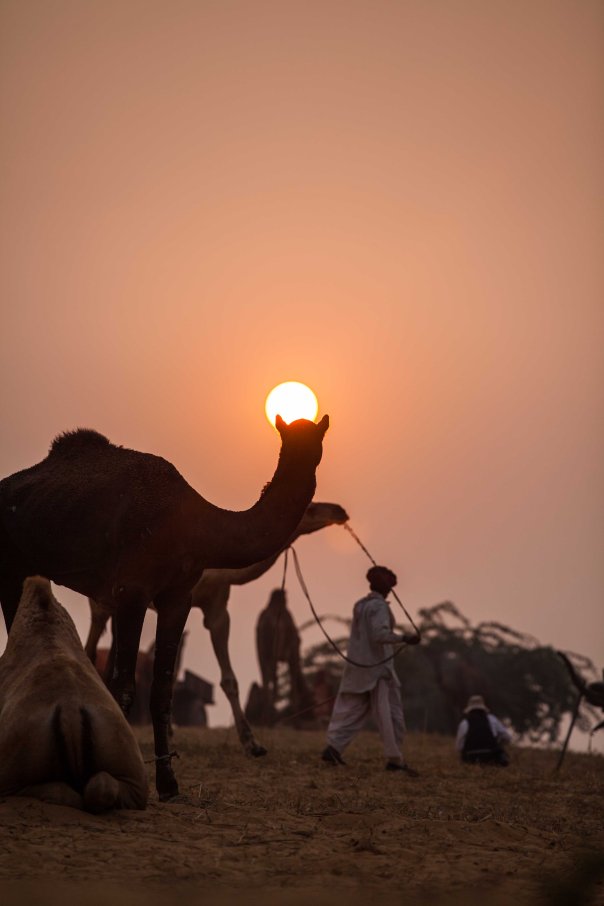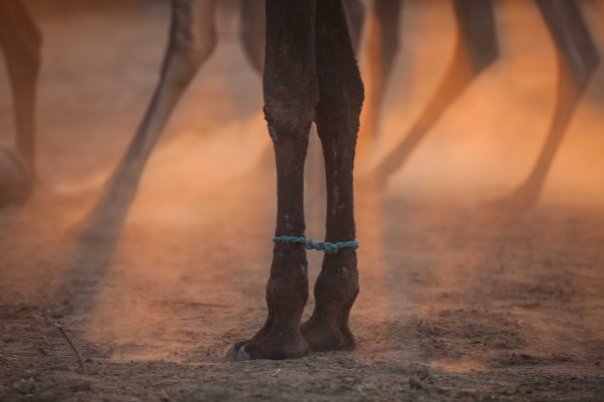The sun shone like a glistening orb, that winter afternoon, engulfing the vast rocky ridges of the Aravalli Hills in a dense yet mystical haze of pale gold. Wrapped in a cowl of mist, the mountain ranges beamed with such intensity that the entire town of Pushkar resonated with life at every step. And, far from the outcries of a modern civilisation or a life that succumbed to wanton attributes, the nomads had once again descended unto the soils of the holy land, as was customary for centuries, to celebrate the spirit of spirituality and sound the clarion call for human connection. Though the Pushkar Camel Fair has transformed, evolved and perhaps lost its true identity over the years; the ancient tradition of travelling from far and wide to the barren dunes has been kept alive by the gypsy tribes even today.
As we approached the dunes that were now dotted with camels, horses and tents, the atmosphere turned electric; older folks were huddled around campfires deeply engrossed in conversations while ladies and children gathered camel dung in tiny wicker baskets. Dressed in traditional attires, that enlivened the ancient identity of Rajasthan, these desert dwellers offered a thrilling insight into the lives of those immersed in a culture quite unlike anything that can be witnessed or experienced in this lifetime. There was a sense of timelessness in those gritty landscapes. It almost seemed as if the entire cosmos came to a standstill to pay homage to a tradition that has been thriving for thousands of years.
A lot of tourists travelling on camel carts or even riding a camel were seen gawking at the villagers while the rural folks continued staring profusely at them. It felt as if they were amazed to meet each other. To each of them, the other group seemed much more exotic and mysterious. It was a congregation of different entities; a moment when two extreme worlds were face to face with each other — the urban and rural — and yet there was a sense of harmony lingering in the air.
The ghats reverberate with divine sounds. All animals including camels, cows, horses, squirrels, monkeys and human beings live together sans any animosity here in Pushkar. Each and every person is a lost entity and somehow coming to the banks of Pushkar Lake, caressing the calm waters and taking a dip in the holy water takes a new meaning and purpose for each of these individuals. The humble act of being one with water brings forth a certain amount of tranquility in all. Men, women and children alike all stranded on the shores bracing themselves, as they enter the water arms folded and deep in meditation, one may wonder why does it mean so much to them? The essence of spirituality prevalent in the air has a profound effect on everyone.
Initially, we were treated as outsiders; people who have come from farther lands and greener pastures. However, as we sat down to get to know each other and once we realised that our problems might be similar, once we realised that we are all confined by similar issues, something magical happened. All of a sudden no longer were we two separate entities trying to correlate or coax ourselves into experiencing things that were alien to us, instead, we were individuals connecting with each other. And, at that moment, the line of distinction dissipated, the circle of individuality dissolved and what arose was a beautiful relationship of trust and companionship.
The Kalbelia clan
Our curiosity led us into the sandy corners of the camp. The grounds were mostly filled with tribes who had travelled from remote areas of Rajasthan and have been doing so for generations. Some of the families told us that they had been travelling for months together. It is a part of their culture. Neither do they have any desire to consider a permanent settlement nor are they unhappy with their lifestyle. After all, this is what their ancestors did. This is what defined their identity. This is what they were destined to do… As we walked towards the end of the camp, we came across a family that had three generations travelling together. Wreaths of smoke swirled up in the cold air and the entire area that housed their tents bustled with life. Everything about them seemed synchronised. They all stayed together, ate together and slept together. They had been living and travelling together for decades.
With sun scorched faces and matted brown hair, the entire clan was dressed in traditional attire. While the girls wore floral salwar kameez with patterned veils on their heads, the men were dressed in shades of black and green. Unlike the usual vibrant tribal colours, their appearance drifted towards sombre hues.
The family belonged to a tribe called Kalbelia who are often believed to be descendants of one of the tribes that left Egypt with the Moses gypsies. Though the theory has been disputed on numerous occasions, there has been no formidable proof or citation on the lineage of these tribes. Primarily, their occupation involved catching snakes and trading poisonous venom. Therefore, their dance movements and attires always bore a striking resemblance to serpents. History suggests that there were several travelling sects co-existing in the North Western region of the Indian subcontinent. Around 1,500 years ago, migration led to the scattering of these tribal groups all over Europe and West Asia. Eventually, names dissolved, groups merged and new gypsy trends emerged. However, their ancient identity remained intact.
Today, they might be known by different names like Kalbelia (Rajasthan), Roma (Iran, Turkey, Romania, Slovakia and Macedonia), Gitan (South of France) and Gitanos (South of Spain), however, they all share the same intrinsic ancient culture and tradition that kept them bound for centuries. According to linguistics, the Romani (popularly known as gypsies in the modern era) are said to have hailed from Rajasthan. Moreover, their language also had words like pani (water), tato (hot) and dhud (milk) — all of which share Sanskrit roots. Genetic studies show that the kalbelias are one of the few Indian tribes from which the Romani are believed to be originated. Apart from adopting a lifestyle that worships performing arts, the tribe quite interestingly used the demonym kale back in the days to describe themselves.
When we met Satpal’s Family
Unlike folkloristic tales or the romantic notions of mysticism assosiated with Kalbelias, the family we met mere quite adept at keeping up with changing times. Though their beliefs and notions seemed quite jaded to us, initially, their unabashed enthusiasm and warmth led us to shed all preconceived notions about the group. Our chance encounter with them allowed us to explore the harsh realities of these tribal groups that survive solely by travelling for eight months in a year, hopping from one animal fair to the other.
Jocund by nature, the group travelled on camel carts throughout the year. With time, they have mastered the art of setting up temporary homes wherever they go. Despite having no formal education whatsoever, these villagers were extremely warm and receptive towards us. On several occasions, their curiosity got the better of them and they would unleash a volley of questions — Who are you? Which country have you come from? What will you do with our pictures?
Kids gathered around us demanding chocolates and sweets. A lady asked me if I would give her my necklace. I politely declined. Everyone joked around with everyone else. There was no pretentious hierarchy followed in this family. Grandchildren would tease and taunt everybody including their fathers and grandfather. There was one kid who studied till the 10th grade. They all treated him with a lot of respect. “Ye padhe likhe hain (He is educated),” Nimani and Pooja, two teenagers who were travelling with their parents, crooned in unison. They also had a rooster whom they named Mithun Chakraborthy. They don’t organise rooster fights but they kept theirs fit nonetheless and told us that they were ready for a show down in case someone challenged them for a fight. However, discretion forms a major part of such acts.
Girls are not educated in the tribe since ‘it does not conform to their beliefs’. Satpal, one of the guys travelling with the group, said that even if he wanted to he couldnot educate his girls for it would be considered blasphemous. He ardently hoped to have a boy and promised that he would give his heart and soul to ensure that he gets a good education. Satpal also showed us his tattoo; a crude rendition of two names — Satpal and Sunita. He said that his wife ran away and he decided to marry another woman whose name was Sunita; that way he wouldn’t have to worry about changing his tattoo.
The elderly folks also told us that girls were not even allowed to sit on the charpai with men. In fact, according to tradition they shall only occupy seats next to a man’s feet. In Rajasthan, the stark distinction created between a girl and boy is blatantly visible. While the former is considered a curse, the latter’s birth is often greeted with victory and a sense of pride. None of these were narrated with any malafide intent or disrespect but rather as a matter of fact. While an urbanite might be flabbergasted by the idea, for the rural folks it is quite a common notion.
Almost everyone smoked zulfa in chillums or hookahs — men, women, kids and the elderly folks. Music too forms a big part of their culture. It was an absolute delight to sit and watch them play a dholak while singing popular songs in Punjabi and Rajasthani. Their eyes gleamed with joy as they all connected with rhythms and melodies.
In fact, Dadaji and Dadiji, who were just in their mid forties, invited us for dinner and we decided to spend the rest of the evening with them. She made the most scrumptious rotis and aloo gobi sabji that were redolent with spices and ghee. We also had some tea with jaggery. Once, we realised that we had emancipated all worldviews of separation with respect to social and economic status, the family welcomed us with open arms. They were extremely forthcoming and had no qualms about sharing their ‘life’ stories with us . They insisted that we had dinner with them and that we rent out tents in the area.
One of the teenage boys, who called himself Ram Jaane, confided in us that he wished his life was better and that it was different. “We have no life”, he said. The elders, on the other hand, felt quite the opposite. “We have the best life. No one lives a life of happiness and freedom as we do. We sleep where we want. We eat where we want. We are the masters of our own destiny. We aren’t answerable to anyone. We have all the freedom we want to; to live a life without any worries,” said Dadaji as he smoked his hookah.
Though the older folks have primarily considered the gypsy culture as a part of their lifestyle, the younger generation seemed to be at a crossroads in their life — a transitional phase — where on one side lies the traditional life of a gypsy and on the other the dream of a modern notion of a life that encompasses comfort, education, job and a settled home. They foresaw no progress or meaning in adopting a lifestyle that forced them to be travellers rather than settlers. Even they wished to give into the new globalised sense of a good life style and saw no charm in a way of life that might seem mystical and adventurous to us urban folks.























